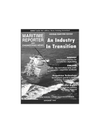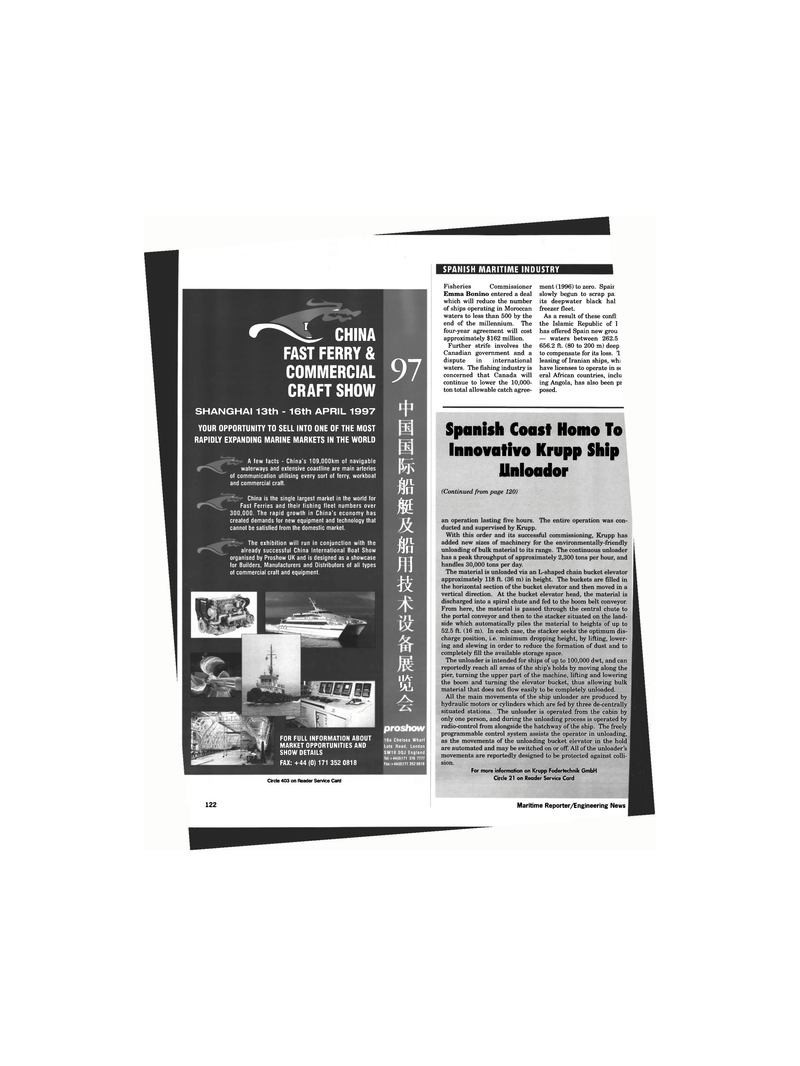
Page 122: of Maritime Reporter Magazine (September 1996)
Read this page in Pdf, Flash or Html5 edition of September 1996 Maritime Reporter Magazine
SPANISH MARITIME INDUSTRY ^^ CHINA
FAST FERRY &
COMMERCIAL
CRAFT SHOW
SHANGHAI 13th - 16th APRIL 1997
YOUR OPPORTUNITY TO SELL INTO ONE OF THE MOST
RAPIDLY EXPANDING MARINE MARKETS IN THE WORLD 97
A few facts - China's 109,000km of navigable waterways and extensive coastline are main arteries of communication utilising every sort of ferry, workboat and commercial craft.
China is the single largest market in the world for
Fast Ferries and their fishing fleet numbers over 300,000. The rapid growth in China's economy has created demands for new equipment and technology that cannot be satisfied from the domestic market.
The exhibition will run in conjunction with the already successful China International Boat Show organised by Proshow UK and is designed as a showcase for Builders, Manufacturers and Distributors of all types of commercial craft and equipment. fr/1 73P m #L 73P fl! ft
IIAr !aL 16a Chelsea Wharf
Lots Road, London
SW10 OQJ England
Tel:+ 44(0)171 376 7777
Fax:+44(0)171 352 0818
FOR FULL INFORMATION ABOUT
MARKET OPPORTUNITIES AND
SHOW DETAILS
FAX: +44 (0) 171 352 0818
Fisheries Commissioner
Emma Bonino entered a deal which will reduce the number of ships operating in Moroccan waters to less than 500 by the end of the millennium. The four-year agreement will cost approximately $162 million.
Further strife involves the
Canadian government and a dispute in international waters. The fishing industry is concerned that Canada will continue to lower the 10,000- ton total allowable catch agree- ment (1996) to zero. Spair slowly begun to scrap pa: its deepwater black hal freezer fleet.
As a result of these confl: the Islamic Republic of 1 has offered Spain new grou — waters between 262.5 656.2 ft. (80 to 200 m) deep to compensate for its loss. 1 leasing of Iranian ships, whi have licenses to operate in st eral African countries, inclu ing Angola, has also been pi posed.
Spanish Coast Homo To
Innovativo Krupp Ship llnloador (Continued from page 120)
Circle 403 on Reader Service Card 122 an operation lasting five hours. The entire operation was con- ducted and supervised by Krupp.
With this order and its successful commissioning, Krupp has added new sizes of machinery for the environmentally-friendly unloading of bulk material to its range. The continuous unloader has a peak throughput of approximately 2,300 tons per hour, and handles 30,000 tons per day.
The material is unloaded via an L-shaped chain bucket elevator approximately 118 ft. (36 m) in height. The buckets are filled in the horizontal section of the bucket elevator and then moved in a vertical direction. At the bucket elevator head, the material is discharged into a spiral chute and fed to the boom belt conveyor.
From here, the material is passed through the central chute to the portal conveyor and then to the stacker situated on the land- side which automatically piles the material to heights of up to 52.5 ft. (16 m). In each case, the stacker seeks the optimum dis- charge position, i.e. minimum dropping height, by lifting, lower- ing and slewing in order to reduce the formation of dust and to completely fill the available storage space.
The unloader is intended for ships of up to 100,000 dwt, and can reportedly reach all areas of the ship's holds by moving along the pier, turning the upper part of the machine, lifting and lowering the boom and turning the elevator bucket, thus allowing bulk material that does not flow easily to be completely unloaded.
All the main movements of the ship unloader are produced by hydraulic motors or cylinders which are fed by three de-centrally situated stations. The unloader is operated from the cabin by only one person, and during the unloading process is operated by radio-control from alongside the hatchway of the ship. The freely programmable control system assists the operator in unloading, as the movements of the unloading bucket elevator in the hold are automated and may be switched on or off. All of the unloader's movements are reportedly designed to be protected against colli- sion.
For more information on Krupp Fodertechnik GmbH
Circle 21 on Reader Service Card
Maritime Reporter/Engineering News

 121
121

 123
123
